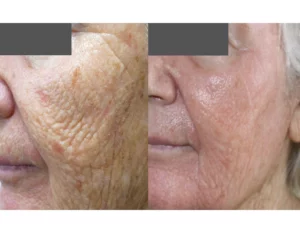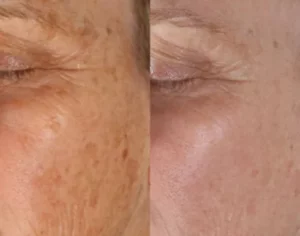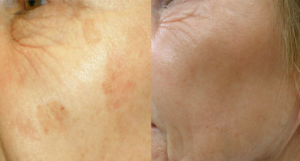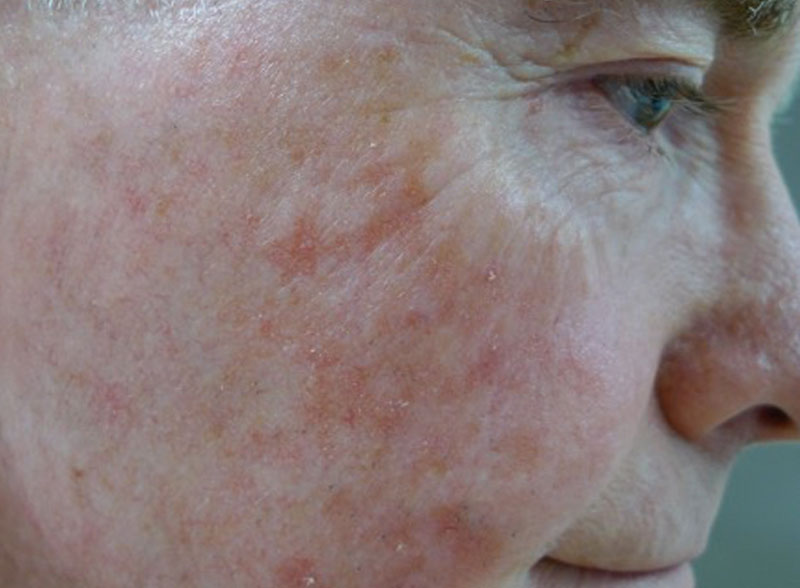Living in sunny regions like Brisbane, the Gold Coast, and the Sunshine Coast undoubtedly comes with its perks, but it also brings an increased risk of sun damage. The intense UV radiation in these areas can lead to a range of skin issues, including age spots, sun spots, brown spots, wrinkles, droopy eyelids, and solar keratosis. While some sun damage is purely cosmetic, others can be precancerous, making it crucial to seek effective treatments and preventive measures. In this comprehensive article, we will delve deeper into various aspects of sun damage, explore why it matters, and provide in-depth insights into treatment options, prevention strategies, and recovery expectations.
Understanding Sun Damage
Sun damage is a broad term that encompasses various skin issues caused by prolonged exposure to the sun’s harmful UV rays. These issues can manifest in several ways, including:
- Cosmetic Sun Damage: This category includes premature wrinkles, age spots, upper lip lines, drooping eyelids, forehead wrinkles, loss of skin volume, and altered skin texture. These concerns primarily affect the appearance of your skin and can be addressed for cosmetic reasons.
- Medical Sun Damage: This type of sun damage goes beyond cosmetics and requires medical attention. It includes red, rough, and persistent areas of solar keratosis, which are precancerous lesions. Some brown spots may also indicate precancerous conditions like melanoma in situ. These conditions necessitate treatment and close monitoring by a medical dermatologist.

Skin Cancer Treatment Cutis Dermatology
Importance of Treating Sun Damage
Treating sun damage is essential for several reasons:
- Early Detection of Skin Cancer: Sun damage, especially in its medical form, can be a precursor to skin cancer. Regular skin checks by a dermatologist can help identify and address potential cancerous lesions before they progress.
- Preventing Skin Cancer: Treating sun damage, especially medical sun damage like sun spots and solar keratosis, can reduce the risk of developing skin cancer.
- Cosmetic Improvement: Sun damage treatment not only addresses medical concerns but also improves the appearance of your skin. It can help reduce wrinkles, pigmentation, and skin laxity, leading to fresher and younger-looking skin.

Skin Cancer
Sun Damage Treatment Options
There are several treatment options available for sun damage, ranging from creams to laser therapies and photodynamic therapy (PDT). Here, we’ll delve into each treatment option to provide a comprehensive understanding of their benefits and considerations:
- Creams: Creams like Efudix, Aldara, Picato, and Solaraze can be used to treat sun damage. These topical treatments are effective for various sun-related issues, but the choice of cream and treatment duration depends on the severity of the damage. These creams can be supervised by your GP, skin cancer doctor, or dermatologist.
- Laser Therapy: Laser treatment is often considered the most effective option for sun damage. High-density lasers like 1927 Fraxel and LaseMD are used to address various aspects of sun damage, including pigmentation, wrinkles, and skin laxity. Laser therapy offers comprehensive results, making it a preferred choice for many patients.
- Photodynamic Therapy (PDT): PDT is an excellent treatment for red, scaly solar keratosis and early-stage skin cancers. It involves a one-time application of a photosensitizing agent followed by exposure to a specific light source. Recovery typically takes 5-7 days, and PDT is covered under certain insurance plans, including DVA (Department of Veteran Affairs) and some international health insurance policies.
- Chemical Peels: Chemical peels are another viable option for sun damage. For sunspots and mild sun damage, AHA glycolic peels are a good starting point. More severe sun damage requires deeper peels like the Jessner-TCA peel or the Obagi Blue Peel. These medium to deep peels can offer significant improvements but may involve downtime ranging from 8 to 14 days.

Fraxel Laser
Choosing the Right Treatment
The choice of treatment depends on various factors, including your age, the severity of sun damage, your desired outcomes, and your skin type. Consulting with a dermatologist is essential to determine the most suitable treatment plan for your specific needs. Your medical provider will carefully assess your skin condition and provide personalised recommendations to achieve the best results.
Recovery Time for Sun Damage Treatments
The recovery time after sun damage treatments can vary based on the specific procedure and the extent of sun damage being addressed. Here’s a breakdown of the expected recovery times for some common treatments:
– PDT: Recovery typically takes 7-8 days.
– Fraxel 1927 High-Density Laser or LaseMD: Expect a recovery period of 5-7 days.
– Fully Ablative Erbium and CO2 Combination Laser: Recovery can take up to 10 days.
It’s important to note that the duration of recovery is often proportional to the level of sun damage being addressed. While longer downtime may be necessary for more severe damage, it often results in more significant improvements. Discuss your expectations and concerns with your dermatologist to set realistic recovery and outcome expectations.

Fraxel Before & After
Insurance Coverage for Sun Damage Treatments
Understanding the coverage of sun damage treatments under insurance policies is crucial to plan your treatment journey effectively:
Medicare: Unfortunately, Medicare does not cover sun damage treatments such as PDT or laser therapy.
Department of Veteran Affairs (DVA): DVA provides 100% coverage for PDT for solar keratosis of the face and certain precancerous squamous cell cancers anywhere on the body or face. This coverage ensures that eligible individuals can access necessary treatments without financial burdens.
Private Health Insurance: Some private health insurance plans offer partial coverage for PDT, depending on the specific health fund. Coverage amounts can range from $50 to $110 or more, depending on your policy. It’s essential to review your insurance plan and consult with your provider to understand the extent of coverage for sun damage treatments.
A Closer Look at Fraxel High-Density Laser
Fraxel laser has revolutionized the management of sun damage. Unlike traditional cream applications associated with weeks of redness, scabs, and itching, Fraxel offers a more advanced and efficient approach to addressing sun-related concerns. Here are some key highlights of Fraxel laser treatment:
Effectiveness: Studies on sun damage and Fraxel laser have shown exceptional results, with clearance rates approaching 95% at 12 months for solar keratosis. This treatment is more effective than PDT and offers a quicker recovery time than other sun spot treatments. The remission period from fractional laser is shorter (14-24 months) compared to topicals like Efudix (>18 months).
Global Recognition: Fraxel high-density laser treatment, pioneered by dermatologists like Dr. Davin Lim, has gained worldwide recognition as one of the premier treatments for solar keratosis and sun damage. Centers in the United States, as well as regions in Australia (including NSW, Victoria, and South Australia), have adopted Dr. Lim’s High Density Fraxel method. Multicenter studies are now being conducted, with more scientific papers on this method expected to be published in the coming year.
Cosmetic and Medical Benefits: Fraxel laser not only treats medical sun damage but also offers cosmetic benefits. It addresses issues like wrinkles, age spots, and pre-cancerous cells, providing a dual advantage. This multifaceted approach reduces the chances of certain forms of skin cancer while also rejuvenating your skin.
Will My Wrinkles and Age Spots Also Disappear with Laser Treatment?
Yes, fine wrinkles and age spots can significantly improve with Fraxel laser or LaseMD treatment. However, if you desire marked wrinkle reduction, especially around the eyes, and seek tighter, more toned skin, fully ablative Erbium, and CO2 laser therapy is the treatment of choice. Here’s a closer look at the benefits of each treatment:
Fraxel Laser or LaseMD: These high-density lasers can effectively reduce fine wrinkles and age spots. They are suitable for patients in their early 20s to 40s who may primarily have “spots and dots” of sun damage. Additionally, these lasers improve skin texture and fine lines, resulting in a more youthful appearance.
Fully Ablative Erbium and CO2 Laser: Patients in their late 40s to 70s often have more pronounced age spots, along with concerns like droopy eyelids, deeper wrinkles, and skin laxity. In this age group, fully ablative lasers, including Erbium and CO2, are recommended. These lasers provide remarkable results, effectively turning back the clock by 15-20 years. While these treatments may involve a more extended recovery period, they can deliver transformative outcomes. It’s worth noting that even at any age, if you seek improvement in fine wrinkles and more even skin texture, Fraxel laser remains a viable option.

Age Spots Pigmentation
Recovery Expectations for Different Treatments
Understanding the recovery period associated with each sun damage treatment is essential for planning your skincare journey effectively. Here’s an overview of the expected recovery times for various treatments:
PDT (Photodynamic Therapy): Plan for a recovery period of 7-8 days. PDT offers a relatively short downtime while effectively addressing sun damage, making it an attractive option for many patients.
Fraxel 1927 High-Density Laser or LaseMD: Anticipate a recovery period of 5-7 days. Fraxel and LaseMD laser treatments offer a quicker recovery compared to some other options.
Fully Ablative Erbium and CO2 Combination Laser: Prepare for a recovery period of up to 10 days. While this treatment may require more downtime, the results are often well worth it, especially for patients with more advanced sun damage.
It’s important to remember that the duration of recovery is often proportional to the extent of sun damage being addressed. Deeper and more comprehensive treatments may involve longer recovery times but can also yield more significant improvements in your skin’s appearance and health.
Prevention Strategies for Sun Damage
While effective treatments are available for sun damage, prevention is always the best approach to maintaining healthy skin and reducing the risk of sun-related issues. Here are some essential strategies to protect your skin from further damage:
- Sunscreen: Apply a broad-spectrum sunscreen with at least SPF 30 daily, even on cloudy days. Reapply every two hours when outdoors, and choose a sunscreen that provides protection against both UVA and UVB rays.
- Protective Clothing: Wear protective clothing, such as wide-brimmed hats, long-sleeved shirts, and sunglasses with UV protection. This clothing helps shield your skin from direct sun exposure.
- Seek Shade: Whenever possible, seek shade or create your own shade using umbrellas or hats. Avoid prolonged sun exposure, especially during peak UV hours.
- Regular Skin Checks: Schedule regular skin checks with a dermatologist to monitor your skin for any changes or potential issues. Early detection is key to addressing sun damage and preventing skin cancer.
- Hydration: Stay well-hydrated by drinking plenty of water. Hydrated skin is more resilient and less prone to damage.
- Lifestyle Choices: Avoid smoking and excessive alcohol consumption, as these habits can exacerbate skin damage.
- Healthy Diet: Consume a balanced diet rich in antioxidants and vitamins that support skin health. Foods like fruits, vegetables, and fish can help protect your skin from damage.
Dr. Davin Lim’s Perspective on Sun Damage Treatments
Dr. Davin Lim has contributed significantly to the field of sun damage treatments. With a focus on both cosmetic and medical aspects of sun damage, Dr. Lim’s approach aims to reverse the years of sun-related damage while reducing the risk of skin cancer. Here are some key insights from Dr. Lim:
Cosmetic Enhancement: Dr. Lim prioritises the cosmetic aspects of sun damage, addressing concerns like wrinkling, lines, droopy eyelids, crows feet, sun spots, age spots, and age warts. His goal is to help patients turn back time, rejuvenate their skin, and achieve a more youthful appearance.
Medical Benefits: In addition to cosmetic improvements, laser therapy and PDT treatments also address pre-cancerous cells, reducing the chances of certain forms of skin cancer. This dual benefit underscores the importance of sun damage treatment for overall skin health.
Fraxel High-Density Laser: Dr. Lim’s studies on sun damage and Fraxel high-density laser have garnered worldwide recognition. This treatment offers exceptional clearance rates for solar keratosis and sun damage, with a shorter recovery time than traditional alternatives. Multicenter studies are underway, promising more insights and advancements in this field.
Personalised Treatment: Dr. Lim emphasizes the importance of personalized treatment plans. Each patient’s skin is unique, and tailoring treatments to individual needs ensures the best possible outcomes.
Incorporating a Multifaceted Approach
Addressing sun damage often requires a multifaceted approach. Combining various treatments, preventive measures, and lifestyle choices can provide comprehensive protection for your skin. Here’s how different treatments and strategies can work together to maintain healthy and radiant skin:
Sunscreen and Protective Clothing: Daily sunscreen use and protective clothing can help prevent further sun damage by blocking harmful UV rays.
Regular Skin Checks: Consistent monitoring by a dermatologist ensures early detection of any concerning skin changes or potential issues.
Laser Therapy and PDT: These treatments effectively target existing sun damage, including pigmentation, wrinkles, and pre-cancerous lesions, while rejuvenating your skin.
Healthy Lifestyle Choices: Avoiding smoking and excessive alcohol consumption, staying hydrated, and maintaining a balanced diet support overall skin health.
Combination Treatments: Combining treatments like laser therapy with topicals can enhance the delivery of active ingredients, leading to better results.


